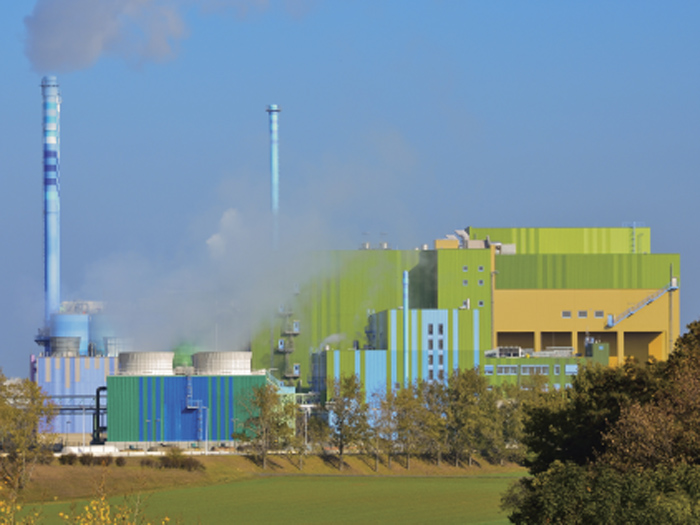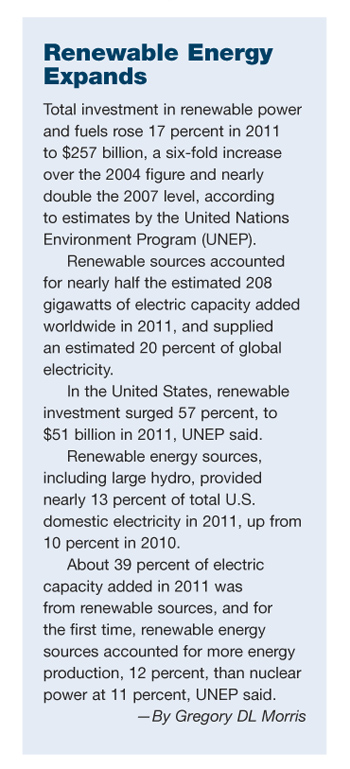Risks in Biomass
Energy’s Quiet Power

By analyst estimates, biomass accounts for about half the alternative energy in the United States. This comes as a surprise to many people, because wind and solar energy get all the headlines.
Burning wood chips or agricultural waste is not sexy. It is also not always simple. For many years, the bulk of biomass facilities were purpose built, often as serendipitous methods of waste disposal.
More recently, older power plants, particularly coal-fired ones, are being partially or completely converted to burn biomass. This raises significant risk management and insurance concerns.
Also, larger commercial-scale biomass facilities are being planned in North America and other countries. Those present other challenges, including project financing and fuel-source reliability. With the exception of project financing, which has limited markets, biomass energy coverage is reported to be readily available, according to brokers and underwriters.
In early September, GCube, one of the leading underwriters for renewable energy, was selected to provide insurance for two large biomass projects in the U.K. One, in Kent, southeast of London, is called Ridham Dock and will be a waste-wood pellet combustion facility that will provide 80 MW (million watts) of electricity. The developer, Renewable Energy Projects, expects the plant to be completed by March 2015.
The second project is a $130 million, 15 MW, combined heat-and-power plant in Belfast, Northern Ireland. It will also use wood waste.
In June 2013, GCube increased its biomass and geothermal construction underwriting capacity to $250 million, to meet increasing market demand.
Risk Management Concerns
One of the first projects to benefit from GCube’s coverage was the 36 MW Mackenzie Bioenergy Project in British Columbia, Canada.
“Worldwide, generating power from wood waste and other biomass is a broad trend in the current age of austerity we are seeing in North America, the U.K. and other countries,” said Jatin Sharma, business development leader, GCube. “This trend also feeds from the shift away from coal to greener fuels, even for older power plants and boilers.”
Sharma said there are five essential risk management concerns in any biomass energy project: regulatory, credit or finance, resource, construction and operational.
“For projects of any size, there is usually some government incentive or credit. Mostly, those are secure, but could be withdrawn at any time. That raises the question of credit risk. Not just for the project, but for the suppliers, contractors and power customers,” he said.
Resource risk is a new one for biomass. For years, plants burned what was at hand. There are now plans to build biomass energy plants in places where the lumber is coming from overseas and the wood for the lumber from a third country, Sharma said.
That is a long supply chain. “There is a risk element to signing a 15-year electricity supply contract for a facility in Africa if the original wood is coming from Sweden or Canada,” he said.
Also, because even the large biomass projects are smaller than standard commercial hydrocarbon fueled power plants, the contractors tend to be smaller firms as well. And while much of the technology is well known, the field is evolving rapidly and components are not yet standardized.
Indeed, managing growth is just as much of a challenge in this business as are specific risks. Global power generation from water, solar, wind and other renewable sources is projected to increase by more than 40 percent, to almost 6,400 terawatt hours, roughly one and a half times the current U.S. electricity production, over the next five years, the International Energy Agency estimated.
“For us, insurance is secondary. Risk transfer is an essential management tool. But engineering comes first.”
— Mark McAdams, high hazard occupancy specialist, FM Global
At the same time, renewable development is expected to increasingly shift from Organization for Economic Co-operation and Development countries to new markets, with emerging countries accounting for two-thirds of the growth.
While solar and wind projects have high visibility, waste-to-energy is not as readily recognized, according to a white paper published at the end of 2012 by ACE USA. In it, Darren Small, vice president and underwriting manager, National Custom Casualty Energy unit, explained that waste-to-energy includes the widest and most diverse spectrum of technologies and products in the renewables field. That makes assessing and managing associated risks more complex.
“In conducting the research for the white paper,” said Small, “we found a wide variety of expertise in risk management among biomass energy operations. That ranged from no risk management focus at all to only just some. We were very surprised at the vagaries in the industry.”
Small added, “In the white paper, we tried to focus that need for comprehensive risk management on the full range of risks: technology, financing, construction, operational, market, and even weather.”
He said it is important to raise awareness both within the biomass energy industry as well as among risk-management professionals, brokers and underwriters.
“This business continues to grow,” he said. “We know because we are adding staff and writing broader risks. We are meeting with more brokers and clients.”
World Leader
In the United States — the world leader in biomass power — biomass plants provide about 8,500 MW of electricity from renewable sources such as wood and agricultural wastes, according to the Biomass Power Association.
In 2011, 75 waste-to-energy plants, a subset of biomass, operated in the United States, with a total capacity of 2,238 MW, according to the U.S. Energy Information Administration.
Generally, biomass is taken to mean the burning of biological material, although it is often imprecise in definition. As an energy source, biomass can be used directly or converted into other products such as biofuels. The process is also carried out at coal-burning plants as a substitute fuel, and common risks arise from the large quantities of light, dry, dusty fuels involved.
“Combustibility, fire, burn back and explosion dominate the risk profile of waste to energy,” according to the ACE report. “A frequent source of concern is that plants may not have been as rigorously designed as befits the power plants that they actually are.
“Project lenders demand greater guarantees against the risks of new and developing technologies,” it said. “Among their concerns are the scope of the warranties that protect revenue streams critical for debt servicing and performance guarantees. A warranty, for instance, may cover a breakdown in machinery but not other losses in production such as business interruption and consequential losses.”
Those costs can far outweigh the cost of the equipment, the report said. In addition, owners and operators need to realize that when warranties expire, the cost of insurance will likely rise. Lenders may require performance guarantees.
“While well-designed systems can serve to reduce the differences between expected and actual output, measuring plant performance over a long period of time presents a risk that is often misunderstood as it involves contractual obligations and complex climate data calculations,” the report stated.
One suggestion from ACE is that a project that has a broad range of protection through insurance — for instance, policies that cover systems performance, warranties or weather — may be more attractive to lenders. Conversely, if the project owners or operators are taking on all the risk, they may have a more difficult time with financing. In most cases, project finance will not become available unless insurance is in place.
Managing Change
“The challenge in the biomass business is managing change,” said Mark McAdams, high-hazard occupancy specialist at FM Global. “The business is not new, but there are a lot of changes. It seems obvious to mix some tire chips in with your coal, but as soon as you start burning things for which the boiler was not built, it is absolutely critical that you review the risk management profile and insurance program on that facility.”
McAdams said that any change in fuel type or feed mechanism also often requires changes in operational and emissions controls, refractory linings, waste management and insurance.
“Trash-burning waste-to-energy facilities from the ’70s and ’80s were the poster children for changing fuel and waste conditions. They suffered a lot of corrosion and erosion,” he said. “You really don’t want to guess or hope. You really want a formal review process. A change in fuel would not likely void insurance outright, but it is a change in operations and a change in exposures, so should definitely be discussed with your carriers and brokers.”
In general, FM Global sees three types of biomass energy facilities: small or mid-sized industrial cogeneration units that are just as much waste management as they are power generation; larger cogeneration facilities that are often connected to other nearby operations or to the power grid; and large commercial power plants.
“Having paid losses in the past on biomass power, we know what questions to ask for any size facility,” said McAdams.
“For us,” he stressed, “insurance is secondary. Risk transfer is an essential management tool, but engineering comes first. Better to eliminate or mitigate risk. In biomass, risks are meaningful and are changing, but are definitely manageable.”
McAdams added that capacity is generally available. Conventional biomass-fired power rates and premiums, terms and conditions
McAdams added that capacity is generally available. Conventional biomass-fired power rates and premiums, terms and conditions are broadly in line with power generation. Waste-to-energy, especially when municipal solid waste streams are in the mix, tend to run more expensive and more restrictive, because of the variability and unknown factors in the feed slate.
There is further complication as biomass develops into biogas and biofuels. “As you move from power generation to chemical transformation, you change the exposure,” said McAdams.
“The old manufacturing-based policies were not up to the challenge,” especially in the area of business interruption, said McAdams, “so we created a new policy that is equally adaptable for biomass or conventional generation.”
David Scott, Utilities Practice leader at Willis, confirmed that capacity for biomass energy is readily available.
“Any market that would write conventional power generation would write biomass,” he said. “We tend to see very similar coverages, rates and terms, with the exception of harvesting methane from landfills. There have been some losses in that segment. Some markets might look twice at that risk, but even there, coverage can be placed. The loss history is just reflected in the premiums and limits.”
Broadly speaking, Scott said that underwriters look favorably on conventional biomass, if always with an eye for fire protection for fuel stocks. He said that if fuels are dry, there can be a risk of dust fires, and if the wood pile is wet, it is subject to spontaneous combustion, similar to damp hay in a barn.
Among conversions, Scott said, one important challenge for insureds and carriers alike is contractor quality and builders’ risk.
“Generally, conversions are favorable under renewable energy strategies and incentives, but you have to look very closely at the reputation of the contractors,” he said.
While the major national and global engineering and construction companies tend to build commercial -scale power plants, biomass conversions are often done by local or regional firms. Those are not necessarily any less capable, but they can carry less coverage.
Willis is also alert to the challenge of project financing.
“Backers of projects are looking for some protection if a project fails,” said Scott. “That is not readily available in some situations. Only a few markets will write, and when they do, it takes a long time to place. And when it is placed, it is expensive: 10 to 15 percent of the insured value. So $10 million of coverage will cost $1 million to $1.5 million for a five-year premium.”
Still, there are signs that new markets are exploring project financing coverage as all types of renewable energy projects grow and spread.
Swiss Re Corporate Solutions commissioned studies that found generation capacity from renewable sources of energy will continue to grow significantly and related investments will reach about $300 billion by 2030. To fund these assets, developers and utilities will increasingly rely on institutional investors.
Renewable energy is also a vital asset in the efforts to mitigate climate change and reduce carbon emissions. For that reason, it is gaining in both economic and political importance.
The Scenarios for Climate Change study, conducted by Swiss Re and partners from the public and private sectors, suggested that low-carbon technologies contributed 23 percent to the global power supply mix in 2010, while fossil fuels accounted for 77 percent.










